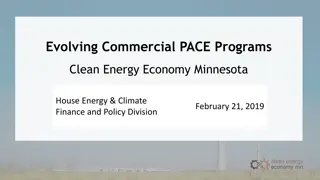Grid Modernization Policies and Barriers to Clean Energy Overview
Explore the efforts of the NC Clean Energy Technology Center in advancing sustainable energy practices, policies, and technologies. Learn about grid modernization, barriers to clean energy, and solutions to enhance access to wholesale markets and promote clean energy initiatives.
Download Presentation

Please find below an Image/Link to download the presentation.
The content on the website is provided AS IS for your information and personal use only. It may not be sold, licensed, or shared on other websites without obtaining consent from the author.If you encounter any issues during the download, it is possible that the publisher has removed the file from their server.
You are allowed to download the files provided on this website for personal or commercial use, subject to the condition that they are used lawfully. All files are the property of their respective owners.
The content on the website is provided AS IS for your information and personal use only. It may not be sold, licensed, or shared on other websites without obtaining consent from the author.
E N D
Presentation Transcript
Grid Modernization Policies and Barriers to Clean Energy David Sarkisian Principal Analyst Policy and Markets North Carolina Clean Energy Technology Center
About the NC Clean Energy Technology Center UNC System-chartered Public Service Center administered by the College of Engineering at North Carolina State University Mission is to advance a sustainable energy economy by educating, demonstrating and providing support for clean energy technologies practices, and policies Objective research, analysis, & technical assistance Manages the Database of State Incentives for Renewables and Efficiency (DSIRE www.dsireusa.org)
50 States Report Series Quarterly publications detailing state and utility changes related to: (1) solar policy & rate design, (2) grid modernization and energy storage, (3) electric vehicles, and (4) decarbonization
What is Grid Modernization? Actions making the electricity system more resilient, responsive, and interactive Smart grid and advanced metering infrastructure Utility business model reform Regulatory reform Utility rate reform Energy storage Microgrids Demand response
Barriers to Clean Energy and Grid Modernization Solutions Access to Wholesale Markets Clean Energy Interconnection DER Aggregation Wholesale Market Expansion Incorporation of Variable Resources Smart Grid Technologies Energy Storage Deployment Time-of-Use Rates DER Compensation Consideration of DER in Planning Processes Integrated Resource Planning Distribution System Planning Utility Business Model/Performance-Based Ratemaking
Access to Wholesale Markets Clean energy projects have had difficulty connecting to wholesale markets Market rules not equipped to handle characteristics of clean energy resources Interconnection backlogs FERC rule changes and wholesale market expansion can/have addressed some issues
Energy Storage Interconnection FERC Order 841 Ensures access to wholesale markets for electric storage resources ISOs/RTOs implemented FERC Order 2023 Reform of interconnection processes Adopts first-ready, first-served system Implementation in early stages
DER Aggregation Smaller DERs can be aggregated to a resource scale that would allow participation in wholesale markets FERC Order 2222 Ensures access to wholesale markets for DER aggregators ISOs/RTOs at varying stages in implementation State opt-out for demand response resources
Wholesale Market Expansion Wholesale markets in new areas can increase access for clean energy resources CAISO Expansion WEIM Expanded Day-Ahead Market SPP Expansion, Markets+ SEEM
Incorporation of Variable Resources Variable resources can be challenging for the grid and older utility rate structures Smart grid technologies and new rate structures can address to some extent
Smart Grid Technologies AMI Can facilitate DER compensation Allows residential-level demand response programs Direct load management programs DERMS Microgrids
Energy Storage Deployment Energy storage facilitates variable resources Storage Targets Maryland Michigan Distributed Storage Incentives Illinois California North Carolina
Time-of-Use Rates Time-of-Use Rates can reward DER for energy provided at peak times Some states/utilities have been moving to mandatory residential time-of-use rates, although there have been some obstacles Rates may include critical peak pricing or real-time pricing
DER Compensation DER compensation rates have been controversial but are moving to more sophisticated structures Illinois compensation for inverters Hawaii energy storage rates
Planning Processes/Utility Business Models Rules can require more thorough consideration of clean energy resources and DERs in utility planning processes Utilities can be given incentives in performance-based ratemaking for incorporation of DERs
Integrated Resource Planning Energy storage playing a large role in many utility resource plans More states requiring or considering legislation to require integrated resource plans IRPs required to align with state clean energy goals
Distribution System Plans Distribution system planning processes can encourage utilities to consider non-traditional alternatives to standard grid investments Non-wires alternatives Illinois Grid Plans
Utility Business Model/Performance-Based Ratemaking Performance-based ratemaking can alter traditional incentives for standard grid and resource investments Performance metrics can include DER incorporation Incentives for energy efficiency, demand response, clean energy and energy storage contracts
Questions? dpsarkis@ncsu.edu 919 521-0523























